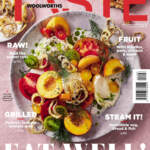Get your (cheese) rind on
Can’t decide whether to taste or toss the outer layer of your favourite wedge of cheese? It might help to know what type of rind you’re dealing with…
WASHED RIND
Washing the exterior of cheeses during the ageing process with brine or alcohol solutions encourages the growth of bacteria that help them ripen and develop their characteristic flavours. The skin of soft, oozy washed-rind cheese such as De Leeuwen is great for snacking, while those of harder ones like Gruyère and Havarti are better for stock-making.
Try: sweetcorn-and-Gruyère soup.
BLOOMY RIND
The white, pliable skins of Brie, Camembert and Wineland Blue develop when cheesemakers spray a solution of edible mould spores onto their surfaces before ageing them. The humidity in the ripening rooms helps the mould to bloom and eventually form a skin. This “live” rind breaks down the cheese on the inside to create its signature creamy texture. Eat the skins with abandon, unless they have developed a strong ammonia whiff.
Try: molten camembert with caramelised apples.
NATURAL RIND
Found on Parmigiano Reggiano and pecorino Romano, these rinds are the result of ageing in temperature- and humidity-controlled ripening rooms where cheesemakers periodically rub them with oil or brine. Over time, the exterior dries out and becomes thick, hard and sometimes gritty – not so fab for snacking on, great for adding intense umami flavour to soups and stocks.
Try: apple-and-pecorino chicken meatballs.
ASH-COATED RIND
French cheeses such as Chèvre and locally produced Chevre Roue are characterised by a thin coating of vegetable-based ash, which is said to neutralise the acidity of the cheese (ash is alkaline) so that mould can grow on the surface and ripen the cheese. Fresh goat’s cheeses like Chevin can also be coated in ash.


Comments